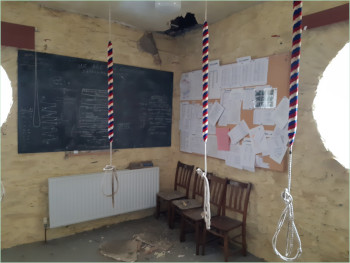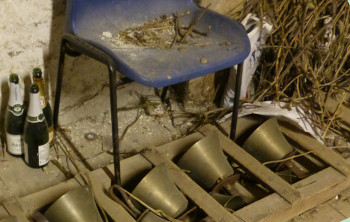Bells not rung regularly #
The following was previously published as a .pdf file on the CCCBR website.

Figure 1: Infrequently used ringing room
We no longer have a team of bell ringers in our village. What do we do to ensure that the bells remain in good order?" #
The answer to this question is complex, as it depends on many factors: the number of times they may be rung and for how long; frequency and quality of past maintenance and inspections; age/type of the installation (old-style or modern); whether belfry and tower is generally well maintained; enthusiasm of the tower authority; and so on.
Modern installations generally require less frequent maintenance than old-style installations. The sealed bearings of modern types won’t deteriorate through inactivity, whereas older style plain bearings will tend to seize up if not used, or dry up if they leak (and this then depends on some regular maintenance and inspection). Also, the woodwork of recent installations will generally be newer, so more durable and less prone to movement by longer-term use and better attachment to other parts.
As a minimum we advise that bells should be rung at least 4 times at intervals through the year, and once a month would be far better. Maintaining bells in good condition is NOT just dependent on the bells being rung. In fact, occasional ringing without any inspection and maintenance could risk more damage and even injury to ringers or others!
Periodic inspection #
This is vital and a professional bellhanger’s annual service contract is ideal, probably essential, if bells are rung infrequently. In this way, the installation will be inspected as for an ‘MOT’ test on a car.
When bells are rung infrequently, (say less than once a month) then it is important for them to be checked every time before and after they are rung by a competent person who is fully familiar with bell installations. The checks could be a condition of ringing the bells, imposed by the the tower authority and should ensure that ropes and stays and other key elements are all in good order, hence minimising risk of injury (and this should be the overriding concern) and / or damage. The tightness of fittings (wood can shrink in hot, dry weather, leaving slackness and movement) should be checked. Additionally, there is the need to look at the frame and the ways it attaches to the tower. The bells themselves may be OK, but frame movement is damaging. The frame may need tightening (especially wooden frames when dry), but it might be more than that, in which case professional help may be necessary. Such an inspection will look for evidence of vermin (especially birds and squirrels). In some locations and certain times of the year, this can be a particular challenge. Squirrels are much more capable of entering because they can wriggle into places that birds can’t. They require professional pest controllers to catch them and, more importantly, kill them, which is what the law demands. All this and more is explained in ‘Belfry Upkeep’.
How can this be achieved? #

Figure 2: Tidy up needed
There is a lot to be gained if one ringer from a neighbouring tower is appointed to look after a rarely rung tower. This is the practice in many areas where towers are not rung regularly. They become familiar with the ring, and develop a knowledge of particular issues that affect that particular installation, since every single one is absolutely unique rather than being mass produced identically. If you do not know who to consult, then your local ringing society should be involved as they will know volunteers who have relevant specialist knowledge who will advise.
Other factors that should be considered if bells are not rung regularly include the experience and knowledge of the tower authority. They will often not be familiar with bells; some may keep the building wind and water-tight, clean and tidy, well maintained and frequently checked, while others are less well set up. Having said that, wellintentioned non-specialists must NOT be expected or asked to do the types of checks mentioned above. We also strongly recommend that the tower, ringing room, and intermediate rooms, and bell chamber are kept accessible, clean and tidy. Having said that, books, records, peal boards, photographs, visitors books, records etc, should NOT be removed or destroyed even if there is no band of ringers. This is likely to contain valuable information.
More positively, we recommend that a band is reinstated at the tower, or arrangements are made for practices to be run at the tower on a regular basis. This is far better than assuming that ringing will not occur. It is recognised that an active band of ringers and regular ringing are often good ways of building and maintaining involvement of the local community with the tower. Neighbours are also accustomed to hearing the sound of bells and will be less likely to object if they are only rung very occasionally. Even while you there are no localringers, regular ringing can be arranged for example, by alternating the practice venue with other local towers. Your local ringing society may well be willing to help get ringing going again, both for practices and services.
Image Credits #
| Figure | Details | Source |
|---|---|---|
| 1 | Infrequently used ringing room | Photo: CCCBR |
| 2 | Tidy up needed | Photo: Alison Hodge |
Previous Chapter - Next Chapter
Disclaimer #
Whilst every effort has been made to ensure the accuracy of this information, neither contributors nor the Central Council of Church Bell Ringers can accept responsibility for any inaccuracies or for any activities undertaken based on the information provided.
Version 1.1, December 2022
© 2022 Central Council of Church Bell Ringers